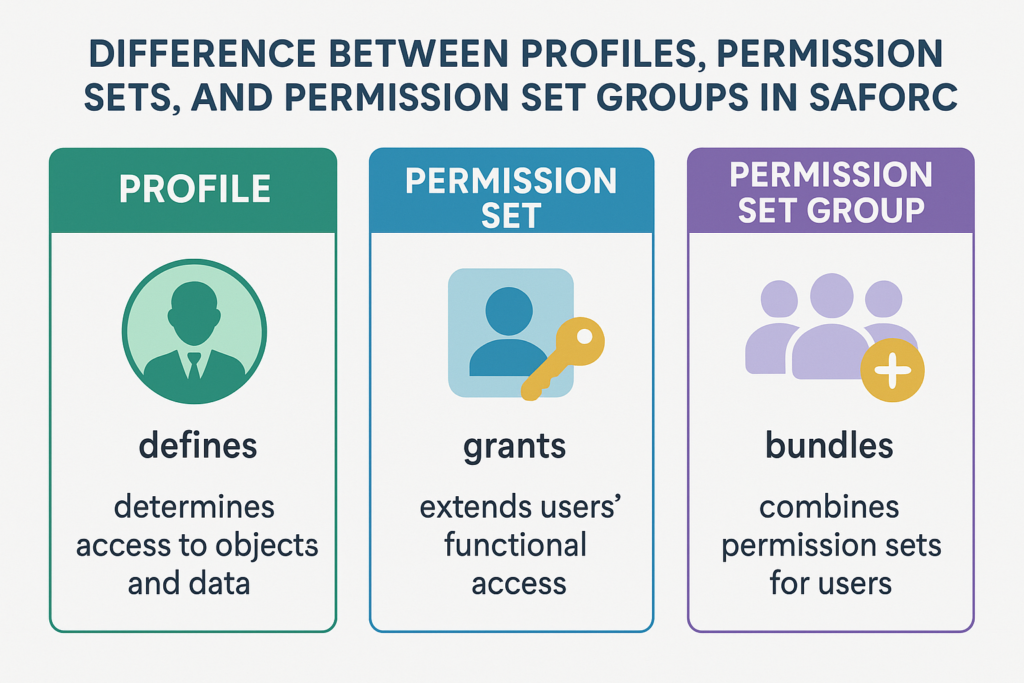Difference Between Profiles, Permission Sets, and Permission Set Groups in Salesforce
One of the most important aspects of Salesforce administration is managing who can access what inside your org. The Salesforce Security Model provides multiple tools to control access, but three often confuse beginners and even experienced admins: Profiles, Permission Sets, and Permission Set Groups.
Let’s break down their purpose, differences, and when to use each.
1. Profiles: The Foundation of Access
A Profile is the baseline of security settings for a user in Salesforce. Every user must be assigned exactly one profile.
Key Characteristics of Profiles:
-
Define object-level permissions (CRUD: Create, Read, Update, Delete).
-
Control field-level security.
-
Manage tab settings (Default On, Off, Hidden).
-
Govern app visibility.
-
Define record types and page layouts.
-
Enforce login hours and IP ranges.
👉 Think of a Profile as a blueprint that sets the minimum level of access for a user.
Example:
-
A Sales Profile might allow access to Leads, Opportunities, and Accounts.
-
A Service Profile might allow access to Cases, Knowledge Articles, and Accounts.
2. Permission Sets: Flexibility Beyond the Profile
While profiles define the baseline, often users need additional permissions without changing their entire profile. That’s where Permission Sets come in.
Key Characteristics of Permission Sets:
-
Add extra permissions on top of the user’s profile.
-
Can be assigned to multiple users (1-to-many).
-
A single user can have multiple permission sets.
-
Provide flexibility without cloning or creating new profiles.
👉 Think of Permission Sets as add-ons to the baseline profile.
Example:
-
A Sales Rep (with Sales Profile) occasionally needs access to Campaigns. Instead of modifying the profile, just assign a “Campaign Access” Permission Set.
-
A Service Agent (with Service Profile) needs Reports & Dashboards access → Assign a “Reporting Permission Set”.
3. Permission Set Groups: Bundling Permissions Together
In large organizations, users often need a combination of permission sets. Assigning them one by one becomes inefficient.
That’s why Salesforce introduced Permission Set Groups.
Key Characteristics of Permission Set Groups:
-
Bundle multiple permission sets into one group.
-
Users get all permissions contained in the group.
-
Simplifies management in large orgs.
-
Supports muting permissions (remove specific permissions within a group without editing the original set).
👉 Think of Permission Set Groups as a combo meal of multiple permission sets.
Example:
-
Marketing Power Users Group = Campaign Access + Reports Access + Dashboard Access.
-
Project Managers Group = Project Object Access + Timesheet Access + Custom App Access.
📊 Comparison Table
| Feature | Profile | Permission Set | Permission Set Group |
|---|---|---|---|
| Mandatory? | Yes (1 per user) | No | No |
| Purpose | Baseline access | Additional access | Combine multiple permission sets |
| Assignment | One per user | Many per user | Many per user |
| Best Use Case | Define core job function | Grant temporary/specific access | Simplify multiple permission assignments |
When to Use What?
-
Profiles → Use for defining core job roles (Sales, Service, Marketing, Admin).
-
Permission Sets → Use for exceptions and additional access (e.g., a Sales rep who also needs Campaign access).
-
Permission Set Groups → Use for bundling common sets of permissions required by a group of users (e.g., power users, managers).
✅ Best Practices
-
Keep profiles minimal – Use them to establish baseline access.
-
Use permission sets generously – Assign extra access as needed.
-
Group permission sets for efficiency – Especially in large orgs with multiple roles.
-
Avoid profile proliferation – Too many profiles create admin overhead.
-
Audit regularly – Use tools like Salesforce Optimizer or Security Health Check.
🔎 Final Thoughts
Profiles, Permission Sets, and Permission Set Groups are complementary tools in Salesforce’s security model.
-
Profiles define the foundation.
-
Permission Sets provide flexibility.
-
Permission Set Groups bring scalability.

